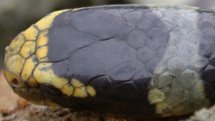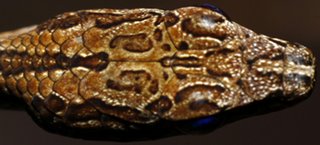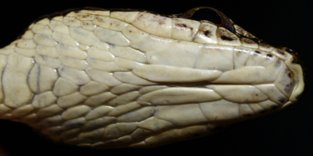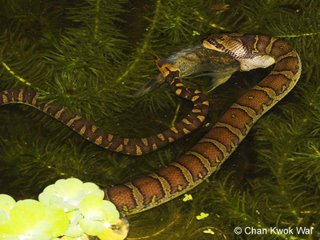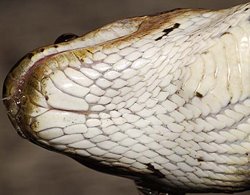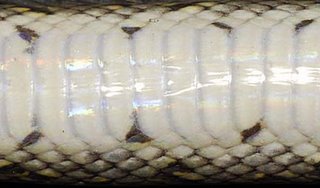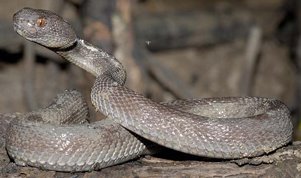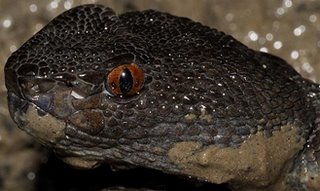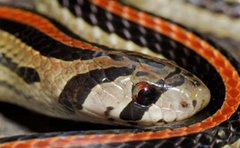 Dionne Teo found a dead House Wolf Snake (Lycodon capucinus) along the roadside of Florissa Park on 12 June 2006 at 8.15 am. The snake was in an awkward position, biting on its own mid-body. No injuries were detected. I wonder what is the cause of the mysterious death!
Dionne Teo found a dead House Wolf Snake (Lycodon capucinus) along the roadside of Florissa Park on 12 June 2006 at 8.15 am. The snake was in an awkward position, biting on its own mid-body. No injuries were detected. I wonder what is the cause of the mysterious death! This nocturnal species (Lim & Lee, 1989; Lim & Lim, 1992; Cox et al., 1998) is commonly found in buildings (Lim & Lee, 1989), and also inhabits dry forested areas and cultivated areas (Cox et al., 1998). It possesses remarkable climbing abilities, and often lives in cracks and crevices of walls or timber (Lim & Lee, 1989). It’s favourite prey is geckos (Lim & Lee, 1989; Lim & Lim, 1992), but it also feeds on other lizards and frogs (Cox et al., 1998). The prey is seized by the head and held in the snake’s coils till it is finally subdued (Lim & Lee, 1989). This non-venomous snake (Lim & Lee, 1989; Lim & Lim, 1992) is generally quite inoffensive (Lim & Lim, 1992).
This nocturnal species (Lim & Lee, 1989; Lim & Lim, 1992; Cox et al., 1998) is commonly found in buildings (Lim & Lee, 1989), and also inhabits dry forested areas and cultivated areas (Cox et al., 1998). It possesses remarkable climbing abilities, and often lives in cracks and crevices of walls or timber (Lim & Lee, 1989). It’s favourite prey is geckos (Lim & Lee, 1989; Lim & Lim, 1992), but it also feeds on other lizards and frogs (Cox et al., 1998). The prey is seized by the head and held in the snake’s coils till it is finally subdued (Lim & Lee, 1989). This non-venomous snake (Lim & Lee, 1989; Lim & Lim, 1992) is generally quite inoffensive (Lim & Lim, 1992). House Wolf Snake lays clutches of 3-11 eggs (Lim & Lee, 1989; Cox et al., 1998), and the young hatch from the eggs after an incubation period of 11/2 months (Lim & Lee, 1989). It can reach a length of 76 cm (Cox et al., 1998).
This species occurs throughout Southeast Asia (Cox et al., 1998).






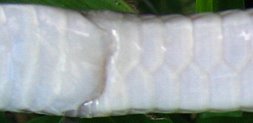

From left to right: Dorsal side of head; Ventral side of head; Inside of jaws; Right side of head; Dorsal side of body; Side of body; Anal Plate; Ventral side of tail.
Sivasothi reported on 1 July 2005, that a House Wolf Snake resided on Hopea sangal wood slices he had left out to dry.
Kctsang caught a House Wolf Snake in a ladies toilet on 26 May 2003, and has some good photographs of the animal here.
“Exploration Trails Gallery” has the photograph of a House Wolf Snake sighted in Pulau Hantu.
* All photographs from Ms Dionne Teo
REFERENCES
Cox, M. J., van Dijk, P. P., Nabhitabhata, J. & Thirakhupt, K., 1998. A photographic guide to snakes and other reptiles of Peninsula Malaysia, Singapore and Thailand. New Holland Publishers (UK) Ltd, p. 12.
Lim, F. L. K. & Lee, M. T. M., 1989. Fascinating Snakes of Southeast Asia – an Introduction. Tropical Press, Kuala Lumpur, p. 30.
Lim, K. K. P. & Lim, F. L. K., 1992. A Guide To The Amphibians & Reptiles Of Singapore. Singapore Science Centre, p. 147.








